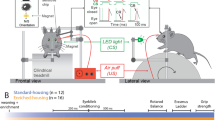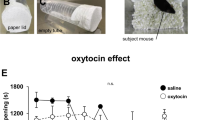Abstract
Automated homecage monitoring systems are now widely recognized and used tools in cognitive neuroscience. However, few of these studies cover pharmacological interventions. Scopolamine, an anticholinergic memory disrupting agent is frequently used to study learning behavior. We studied the impact of scopolamine treatment in a relevant dose-range on activity, drinking behavior and reversal learning of C57BL/DJ mice in a homecage-like, social environment, using the IntelliCage. Naïve mice were first habituated to the IntelliCage, where they learned to nosepoke in any of the four corners in order to gain access to the water reward. Visits, nosepokes, lick numbers and durations were recorded. Mice were then trained to distinguish between a rewarded correct corner and punished, incorrect corners. Later, in the reversal learning phase, the assigned correct corner was rotated clockwise every 24 h. Upon s.c. administration of scopolamine general activity represented by visit and nosepoke numbers increased, but their durations were shorter. Surprisingly, general activity and lick behavior were drastically altered. Scopolamine also significantly reduced the ability to perform a reversal learning task. We not only found significant decline in reversal learning due to scopolamine treatment, but studied the method specific underlying behaviors: the general activity and lick behavior as well.



Similar content being viewed by others
References
Ennaceur A, Delacour J (1988) A new one-trial test for neurobiological studies of memory in rats. Behav Data Behav Brain Res 31:47–59
Morris RGM (1989) Synaptic plasticity and learning: selective impairment of learning in rats and blockade of long term potentiation in vivo by the N-methyl-d-aspartate receptor antagonist AP5. J Neurosci 9(9):3040–3057
Fanselow MS (1980) Conditional and unconditional components of post-shock freezing. Pavlov J Biol Sci 15:177–184
Maki Y, Inoue T, Izumi T, Muraki I, Ito K, Kitaichi Y, Li X, Koyama T (2000) Monoamine oxidase inhibitors reduce conditioned fear stress-induced freezing behavior in rats. Eur J Pharmacol 406:411–418
Ferster B, Skinner BF (1957) Schedules of reinforcement. Appleton-Century-Crofts, New York
Bussey TJ, Padain TL, Skillings EA, Winters BD, Morton AJ, Saksida LM (2008). The touchscreen cognitive testing method for rodents: how to get the best out of your rat. Learn Mem. 15(7):516–523. doi: 10.1101/lm.987808
Crabbe JC, Wahlsten D, Dudek BC (1999) Genetics of mouse behavior: interactions with laboratory environment. Science 284:1670–1672
Wolfer DP, Voikar V, Vannoni E, Colacicco G, Lipp HP (2012). Mouse phenotyping in the IntelliCage: from spontaneous behavior to cognitive function. Meas Behav 2012:66
Chintoh A, Fulton J, Koziel N, Aziz M, Sud M, Yeomans JS (2003) Role of cholinergic receptors in locomotion induced by scopolamine and oxotremorine-M. Pharmacol Biochem Behav 76:53–61
Nomura Y, Nishiyama N, Saito H, Matsuki N (1994) Role of cholinergic neurotransmission in the amygdala on performances of passive avoidance learning in mice. Biol Pharm Bull 17:490–494
Sipos ML, Burchnell V, Galbicka G (1999) Dose-response curves and time-course effects of selected anticholinergics on locomotor activity in rats. Psychopharmacology 147:250–256
Day J, Damsma G, Fibiger HC (1991) Cholinergic activity in the rat hippocampus, cortex and striatum correlates with locomotor activity: an in vivo microdialysis study. Pharmacol Biochem Behav 38:723–729
Hodges DB Jr, Lindner MD, Hogan JB, Jones KM, Markus EJ (2009) Scopolamine induced deficits in a battery of rat cognitive tests: comparisons of sensitivity and specificity. Behav Pharmacol 20(3):237–251. doi: 10.1097/FBP.0b013e32832c70f5
Masuoka T, Fujii Y, Kamei C (2006) Effect of scopolamine on the hippocampal theta-rhythm during an eight-arm radial maze task in rats. Eur J Psychopharmacol 539:76–80. doi:10.1016/j.ejphar.2006.03.046
Humby T, Laird FM, Davies W, Wilkinson LS (1999) Visuospatial attentional functioning in mice: interactions between cholinergic manipulations and genotype. Eur J Neurosci 11:2813–2823
Deiana S, Platt B, Riedel G (2011) The cholinergic system and spatial learning. Behav Brain Res 221(2):389–411. doi: 10.1016/j.bbr.2010.11.036
Klinkenberg I, Blokland A (2010) The validity of scopolamine as a pharmacological model for cognitive impairment: a review of animal behavioral studies. Neurosci Biobehav Rev 34:1307–1350. doi: 10.1016/j.neubiorev.2010.04.001
Stoschus B, Allescher HD (1993) Drug-induced dysphagia. Dysphagia 8:154–159
Robinson L, Riedel G (2014) Comparison of automated home-cage monitoring systems: emphasis on feeding behaviour, activity and spatial learning following pharmacological interventions. J Neurosci Methods 234:13–25. doi: 10.1016/j.jneumeth.2014.06.013
Galsworthy MJ, Amrein I, Kuptsov PA, Poletaeva II, Zinn P, Rau A (2005) A comparison of wild-caught wood mice and bank voles in the IntelliCage: assessing exploration, daily activity patterns and place learning paradigms. Behav Brain Res 157(2):211–217. doi:10.1016/j.bbr.2004.06.021
Ryan D, Koss D, Porcu E, Woodcock H, Robinson L, Platt B (2013) Spatial learning impairments in PLB1 triple knock-in Alzheimer mice are task-specific and age-dependent. Cell Mol Life Sci 70(14):2603–2619. doi: 10.1007/s00018-013-1314-4
Masuda A, Kobayashi Y, Kogo N, Saito T, Saido TC, Itohara S (2016) Cognitive deficits in single App knock-in mouse models. Neurobiol Learn Mem 135:73–82. doi: 10.1016/j.nlm.2016.07.001
Tan T, Watts SW, Davis RP (2011) Drug delivery: enabling technology for drug discovery and development. iPRECIO® micro infusion pump: programmable, refillable, and implantable. Front Pharmacol 2:44. doi:10.3389/fphar.2011.00044
Acknowledgements
This work has been supported by Gedeon Richter Plc, Budapest, Hungary.
Author information
Authors and Affiliations
Corresponding author
Additional information
This work has been supported by Gedeon Richter Plc, Budapest, Hungary.
Rights and permissions
About this article
Cite this article
Pelsőczi, P., Lévay, G. Effect of Scopolamine on Mice Motor Activity, Lick Behavior and Reversal Learning in the IntelliCage. Neurochem Res 42, 3597–3602 (2017). https://doi.org/10.1007/s11064-017-2408-4
Received:
Revised:
Accepted:
Published:
Issue Date:
DOI: https://doi.org/10.1007/s11064-017-2408-4




